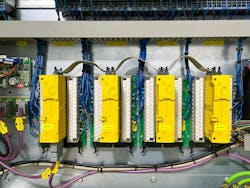Industrial Controllers: Changing Decision Factors
Today’s industrial controllers pack greater levels of processing power, connectivity and scalability than their predecessors and offer greater flexibility to meet specific application needs. For example, programmable logic controllers (PLCs), programmable automation controllers (PACs), and industrial programmable controllers (IPCs) are all now highly customizable.
And as technologies like robotics and artificial intelligence (AI) spread across the manufacturing industries, the number of factors to consider when selecting and deploying industrial controllers continues to grow. To identify these critical factors, as well as how to meet the challenges of deploying new controllers into existing manufacturing systems, Automation World tapped the minds of five industry experts: Wilfred Misener (WM), director of business development for North America industry and IT at Actemium; Michael Fazzini (MF), operations manager at Avanceon; Alex Maercz (AM) product engineer at AutomationDirect; Liz Bahl Prosak (LBP), commercial portfolio manager at Rockwell Automation; and Luis Narvaez (LN), product manager for Simatic controllers at Siemens Industry U.S.
AW: What factors should manufacturers consider when selecting an industrial controller for their specific production needs?
LN: There are many factors to consider for selecting the perfect controller. Chief among these are:
- Is the controller to be installed inside an enclosure (IP20) or outside and mounted on the equipment (IP67/68)?
- Is this a small application (up to 50 I/O points), a medium-size application (up to 100 I/O points), or a large application (greater than 100 I/O points)?
- What programming languages will be used (IEC 61131-3 or other high-level languages, e.g., C++)?
- Are motion control functions required and, if so, what motion functions are required: basic positioning and speed control, enhanced motion or advanced motion control?
- Is there a preference for hardware- or software-based automation? Users can choose from traditional hardware-based, hybrid hardware with high-level programming (e.g., C++), hybrid drive-integrated hardware PLC, software PLC (PC-based), or virtual (hardware independent, virtualized environment).
WF: At Actemium, we analyze the existing installation and evaluate its current state, then consider performance criteria of the equipment and the process to determine user needs. It’s important to validate performance, connectivity, I/O capacity, programming language, scalability and reliability while also considering security.
LBP: Scalability is a significant factor in controller choice. Manufacturers should choose a controller that can grow with their production needs, allowing for future expansion without requiring significant overhauls. Integration is another important factor, as the controller must be compatible with existing systems and should integrate seamlessly with other equipment and software.
Reliability and support are also essential. Manufacturers should consider the reliability of the controller and the availability of support and spare parts. A reliable controller with robust support can reduce downtime and ensure continuous operation. By carefully evaluating these factors, manufacturers can select a controller that meets current needs while supporting future growth.
AW: What challenges are typically unaddressed when implementing new industrial controllers into existing manufacturing systems?
AM: Usability. Choosing a controller with readily available, free-of-charge software makes it far more convenient to keep the equipment running. When the control platform offers plenty of web-based documentation, training materials and videos, users can train more of their maintenance and engineering staff to work with the products, so they can optimize operations and provide plenty of support if needed.
Finally, for interfacing with legacy systems, some controllers require additional hardware and software at an upcharge. Other controller platforms will include native options for these connections out of the box, providing a streamlined solution.
MF: Though challenging, spending adequate time on design and testing documentation always leads to a better result. Including the right people early in the design will reduce the risk and number of changes needed during implementation. This includes having programming standards and verifying that they are adhered to during software development. A commitment to maintaining standards and documentation throughout the process makes executing changes and enhancements much more efficient in the future.
LN: Some of the main challenges often unaddressed include ensuring compatibility between new controllers and existing systems, which can get complicated. Others include:
- Selecting a controller that can integrate with existing systems from sensors to SCADA is important to minimize operational impact.
- The upfront investment for new controllers, can be significant. However, the cost of doing nothing can expose other risks that introduce higher financial impacts such as higher preventive maintenance costs, spare parts availability and price, cybersecurity/ransomware vulnerabilities and lack of experienced labor.
- Workforce resistance. Employees might resist new technologies due to fear of job loss or a break from their comfort zone with a new system.
- Cybersecurity risks. As manufacturers seek to make more data-driven decisions to optimize production, manufacturing systems become more connected and are, therefore, increasingly vulnerable to cyberattacks. Ensuring that manufacturers are implementing the latest technology can lower the impact or risk of cybersecurity events.
- Environmental impact. New controllers can have significant environmental impacts including increased energy consumption and electronic waste.
AW: How do industrial controllers handle scalability and flexibility in manufacturing environments?
LBP: Industrial controllers ensure scalability and flexibility through modular hardware, flexible programming, seamless integration with various systems, scalable communication protocols and regular software updates. These features allow manufacturers to easily expand, adapt and maintain their systems efficiently in a dynamic production environment.
AW: What measures are taken to ensure the security and reliability of industrial controller systems in manufacturing, especially considering the growing concerns around cyber threats?
WF: To ensure the security and reliability of industrial controller systems, Actemium takes the following measures into consideration:
- Isolating control systems from the internet and corporate networks where possible. * Restricting access to authorized personnel and devices.
- Use of encryption and protocols like OPC UA, MQTT and HTTPS.
- Regular software updates and patching.
- Deploying intrusion detection and prevention systems.
- Backups and redundancy.
- Secure password management, two-factor authentication, regular security audits and risk assessments.
- Employee training and awareness.
- Compliance with industry standards like IEC 62443, NIST 800-82 and ISO 27001, plus secure hardware design, continuous system monitoring and incident response planning.
AM: Sandboxing, the act of completely isolating a control system from all other digital connections, may be a gold standard for protecting against cyber threats. However, today’s needs, wants and requirements for remote connectivity, visualization and data access often makes complete sandboxing impractical. Therefore, it is more important to use up-to-date controllers that employ strong, industry-recognized methods of encryption paired with granular configuration of individual outward-facing communication ports to be securely locked down, while keeping inward-facing ports available to communicate with legacy equipment at the OT layer.
From a larger system design perspective, every controller should be protected behind a firewall or VPN. Furthermore, all unused controller services, protocols and ports should support being disabled to minimize the overall attack surface.
AW: What do you consider to be the biggest trends in industrial controller technologies that manufacturers should be aware of?
LN: While AI is traditionally implemented with industrial computing technology, expect to see AI technology make its way closer to the PLC. Another trend is the introduction of edge computing. These technologies are enabling more efficient data processing and storage while removing barriers like hardware dependencies, allowing performance to be easily scalable. We see this with the introduction of virtual controllers.
Also, the use of robotics is driving many of innovations in controller technology. With end users having to integrate robotic systems from different vendors in their plants, it’s difficult to have expertise in programming or controlling these systems. Manufacturers need a simple uniform way to program, operate and test diverse robotic systems.
AM: Industrial controller connectivity with the outside world has become one of the top requirements for end users, especially using native support for industrial IoT protocols such as OPC UA and MQTT. Unfortunately, this also means that industrial controllers have increasingly become a target for hackers.
The ability to secure industrial controllers and their protocols has come a long way and users need to ensure they demand these features in a controller platform and then apply them. A related consideration is that many users are leaning toward more open platforms.
WF: The biggest trends in industrial controller technologies include recognizing the capabilities of AI and advanced robotics to enable risk mitigation. Other trends include Industrial Internet of Things (IIoT) for enabling real-time data mining and analysis, as well as edge and cloud computing.
I would add that, choosing a controller has become increasingly difficult in light of the variety and modern features now available. The ability for a controller to perform auto code generation can show users how to realize value-added efficiency gains.

Leaders relevant to this article:





